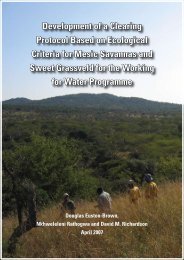Business Case forthe Pongola-Umzimkulu Catchment Management ...
Business Case forthe Pongola-Umzimkulu Catchment Management ...
Business Case forthe Pongola-Umzimkulu Catchment Management ...
Create successful ePaper yourself
Turn your PDF publications into a flip-book with our unique Google optimized e-Paper software.
<strong>Business</strong> <strong>Case</strong> for the <strong>Pongola</strong>-<strong>Umzimkulu</strong> <strong>Catchment</strong> <strong>Management</strong> Agency<br />
3. Public-interest operating subsidy: DWA transfer for functions performed by the CMA<br />
that are in the public interest, rather than for direct water user benefit.<br />
In all of the scenarios, the CMA costs were fixed (at 2012/13 prices) as was the estimate of<br />
registered water use. The former provides a current day indication of charges and subsidies<br />
that may simply be escalated by an assumed inflation rate. The latter assumption is<br />
conservative, but was partially opposed by the assumption that recovery rates would<br />
approach 100% within five years of CMA establishment.<br />
No financial support: Water use charges<br />
The registered water use for urban (domestic-industrial), agriculture (irrigation) and forestry<br />
(streamflow reduction activities) totals 1917 million m 3 / annum and excludes a transfer out<br />
of the WMA of 297 million m 3 / annum. The volumes per sector are shown inTable 5.<br />
Table 5: Water use volumes per sector (million m 3 )<br />
Water Use<br />
Name TOTAL Urban Agriculture Forestry<br />
<strong>Pongola</strong>-UMzimkhulu 1917 940 813 163<br />
The Table 6 below indicates the total costs and the user charges required for full cost<br />
recovery within the CMA. While it is possible to have the CMA fully self-sufficient, it is an<br />
unlikely scenario due to a number of reasons. The first is that the CMA would not be able to<br />
collect 100% of the charges, especially from year 1 and therefore requires an establishment<br />
subsidy to cover the first 2 years of costs. This timeframe also allows for the collection<br />
system to be updated and passed to the CMA to ensure more effective collection of<br />
charges. Since current collection is between 40-80% of charges, a reasonable assumption<br />
can be made that collection of charges shall never exceed 90%. The second is that there is<br />
currently an agricultural cap of 2c/kl, and the current charges when the system stabilises is<br />
more than double the cap amount.<br />
Table 6: Full cost recovery and user charges<br />
Full cost recovery through charges<br />
Year 1 2 3 4 5 6<br />
Total CMA costs 13 826 31 792 46 813 59 492 70 561 84 349<br />
(R’000)<br />
WRM charges (c/kl) 0.72 1.66 2.44 3.10 3.68 4.40<br />
The Table 7 below represents the implications of maintaining the WRM charge cap on<br />
agriculture and forestry, which is set at 2c/kl for the 2012/13 financial year (increasing by<br />
CPI). The analysis is based on including the establishment grant and water use charges for<br />
full cost recovery, except that there is a need for a charge-capping subsidy to be transferred<br />
to the CMA upon delegation of the charge collection function. The basis of the cap is that<br />
this is an affordability issue that must be addressed through fiscal support (not crosssubsidisation<br />
from domestic and industrial users) and that domestic and industrial users do<br />
not generally have an affordability challenge. This scenario partially addresses the<br />
affordability issue for agriculture and forestry, but would need to be implemented<br />
Department of Water Affairs 49
















